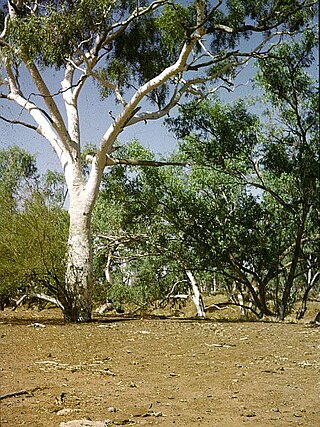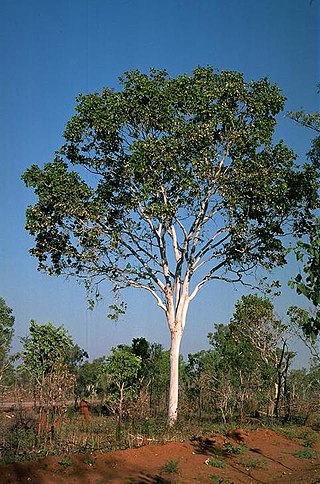
Eucalyptus pulverulenta, commonly known as silver-leaved mountain gum, is a species of straggly tree or mallee that is endemic to southern New South Wales. It has smooth bark, egg-shaped, heart-shaped or round, sessile leaves arranged in opposite pairs, flower buds in groups of three, white flowers and cup-shaped to cylindrical fruit.

Eucalyptus parvula, commonly known as small-leaved gum, is a species of small tree that is endemic to south-eastern New South Wales. It has mostly smooth bark, elliptical to lance-shaped adult leaves but with many juvenile of intermediate leaves in the crown, flower buds in groups of seven, white flowers and cup-shaped fruit.

Corymbia henryi, commonly known as large-leaved spotted gum, is a species of small to medium-sized tree that is endemic to north-eastern Australia. It has smooth, mottled bark, lance-shaped adult leaves, flower buds in groups of three, white or lemon yellow flowers and barrel-shaped to urn-shaped fruit.

Corymbia papuana, commonly known as ghost gum, is a species of evergreen tree native to New Guinea, some Torres Strait Islands and the northern part of the Cape York Peninsula in Australia. It has smooth whitish bark, lance-shaped adult leaves, flower buds in groups of three or seven, creamy white flowers and barrel-shaped or urn-shaped fruit.
Corymbia greeniana is a species of tree that is endemic to northern Australia. It has rough bark on some or all of the trunk and larger branches, smooth bark above, broadly lance-shaped to egg-shaped adult leaves, flower buds usually in groups of seven, creamy white flowers and urn-shaped fruit with a distinct neck.

Corymbia bleeseri, commonly known as glossy-leaved bloodwood or smooth-stemmed bloodwood, is a species of tree that is endemic to northern Australia. It has thin, rough bark on part or all of the trunk, smooth bark above, lance-shaped to curved adult leaves, flower buds in groups of seven, creamy white flowers and barrel-shaped fruit.

Corymbia collina, commonly known as silver-leaved bloodwood, is a species of tree that is endemic to Western Australia. It has thin patchy rough bark on some or all of the trunk, smooth white to pale grey bark above, lance-shaped to curved adult leaves, flower buds in groups of seven, creamy white flowers and barrel-shaped fruit.

Corymbia confertiflora, commonly known as broad-leaved carbeen or rough leaf cabbage gum, is a species of tree that is endemic to northern Australia. It has rough, tessellated bark near the base of the trunk, smooth white to pale grey bark above, a crown of both intermediate and adult leaves, large numbers of flower buds borne on leafless sections of branchlets in groups of seven, creamy white flowers and cylindrical to barrel-shaped or bell-shaped fruit.
Corymbia dendromerinx, commonly known as ghost gum, is a species of tree that is endemic to the south-western Kimberley region of Western Australia. It has smooth bark, sometimes with a stocking of rough bark near the base, a crown of variably-shaped leaves, flower buds mostly in groups of seven, creamy white flowers and barrel-shaped, cylindrical or cup-shaped fruit.

Corymbia erythrophloia, commonly known as red bloodwood, variable-barked bloodwood, red-barked bloodwood or gum-topped bloodwood, is a species of tree that is endemic to Queensland. It has rough bark on the trunk and branches, egg-shaped or lance-shaped adult leaves, flower buds in groups of seven, creamy white flowers and urn-shaped to spherical fruit.

Corymbia ferriticola, commonly known as Pilbara ghost gum, is a species of tree or a mallee that is endemic to Western Australia. It has smooth bark, lance-shaped adult leaves, flower buds in groups of seven, creamy white flowers and shortened spherical to cylindrical fruit.

Corymbia foelscheana, commonly known as broad-leaved bloodwood, fan-leaved bloodwood or smooth-barked bloodwood, is a species of small tree that is endemic to northern Australia. It has thin, rough, tessellated bark on some or all of the trunk, smooth bark above, broadly egg-shaped to broadly lance- shaped adult leaves, flower buds usually in groups of seven, creamy white flowers and urn-shaped fruit.

Corymbia gilbertensis, commonly known as Gilbert River ghost gum or Gilbert River box, is a species of tree that is endemic to tropical far north Queensland. It has rough, tessellated bark on the lower part of the trunk, smooth bark above, a crown of juvenile, intermediate and adult leaves, flower buds mostly in groups of seven, creamy white flowers and cup-shaped to barrel-shaped fruit.

Corymbia grandifolia, commonly known as cabbage gum, large-leaved cabbage gum and paper-fruited bloodwood, is a species of tree that is endemic to northern Australia. It has smooth bark, egg-shaped to broadly elliptic to lance-shaped adult leaves, flowers buds in groups of three or seven, creamy white flowers and cup-shaped to cylindrical fruit.
Corymbia hamersleyana is a species of small tree or mallee that is endemic to the Pilbara region of Western Australia. It has rough, flaky bark on part or all of the trunk, smooth cream-coloured bark above, lance-shaped adult leaves, flowers buds in groups of seven or nine, creamy white flowers and urn-shaped fruit.

Corymbia kombolgiensis, commonly known as scarp gum or paper-fruited bloodwood, is a species of small tree that is endemic to the Northern Territory. It has smooth bark, sometimes with rough, tessellated bark near the base, linear to narrow lance-shaped adult leaves, flower buds usually in groups of seven, white flowers and cylindrical to barrel-shaped fruit.
Corymbia lamprophylla, commonly known as shiny-leaved bloodwood, is a species of tree that is endemic to central Queensland. It has rough, tessellated bark on the trunk and larger branches, lance-shaped adult leaves, flower buds in groups of seven, creamy white flowers and urn-shaped fruit.

Corymbia latifolia, commonly known as round-leaved bloodwood, round leaf bloodwood, wubam and other names in indigenous languages, is a species of tree that is endemic to northern Australia. It has thin, rough bark over part or all of the trunk, smooth bark above, triangular or broadly egg-shaped adult leaves, flower buds in groups of seven, creamy white flowers and urn-shaped fruit.
Corymbia paractia, commonly known as Cable Beach ghost gum, is a species of low-growing tree that is endemic to the Kimberley region of Western Australia. It has smooth white to pale grey bark, sometimes with rough bark near the base of the trunk, lance-shaped adult leaves, flower buds in groups of three or seven, creamy white flowers and cup-shaped, barrel-shaped or cylindrical fruit.
Corymbia polysciada, commonly known as apple gum, paper-fruited bloodwood or bolomin, is a species of tree that is endemic to the Top End of the Northern Territory. It has rough, tessellated bark on some or all or the trunk, smooth bark above, egg-shaped to broadly lance-shaped adult leaves, flower buds in groups of seven, creamy white flowers and cup-shaped, cylindrical or barrel-shaped from on long pedicels.














